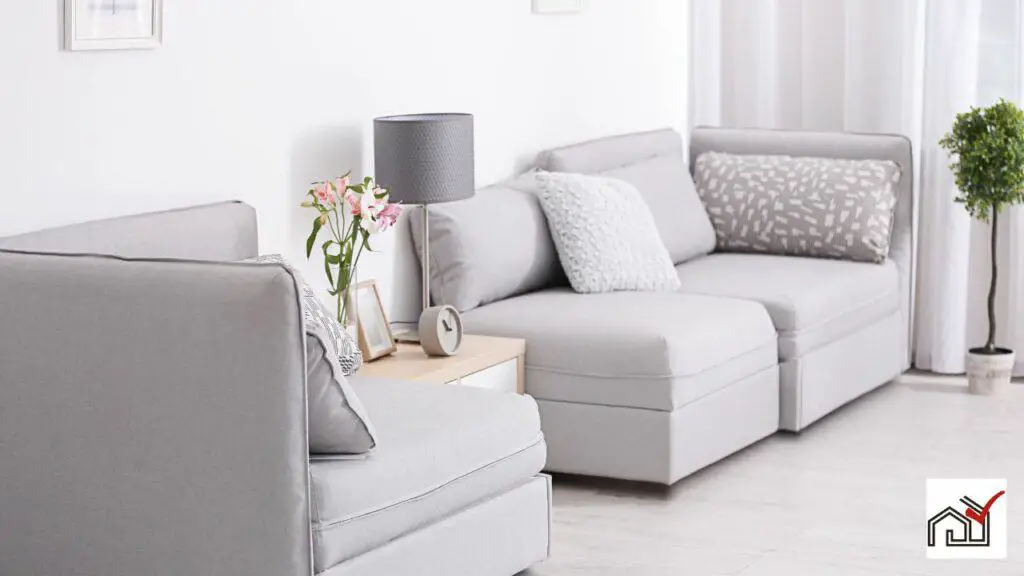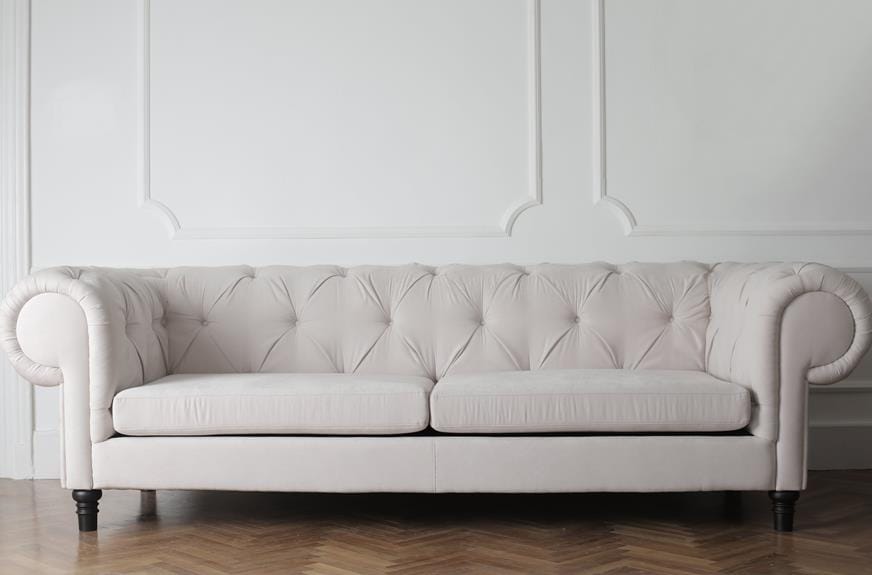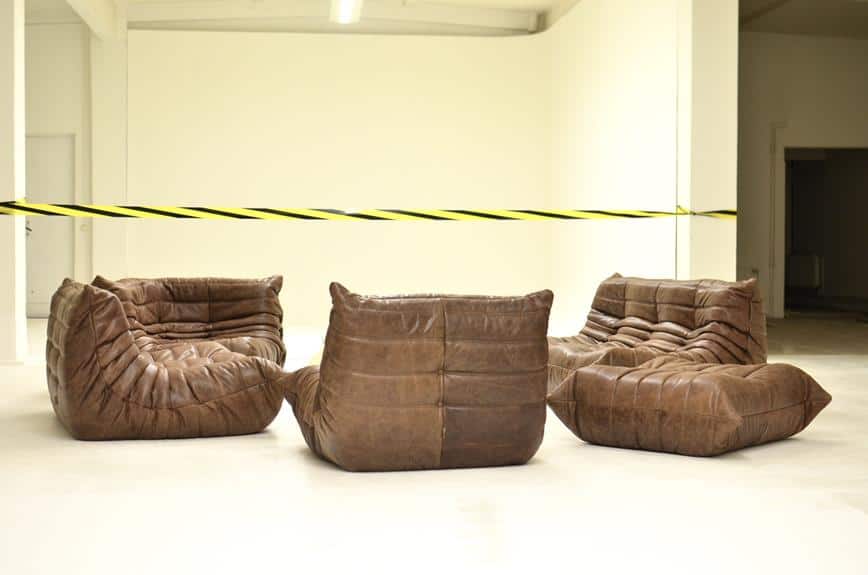Placing furniture correctly in a living room is important for both function and style. When adding a sectional sofa, it should be positioned to make the most of seating, improve room flow, and fit well with the room's design.
Position the sectional to face a main feature like a TV, fireplace, or window. The sectional can also separate areas within the room or be paired with a rug to define its space.
Proper placement makes the sectional a key feature that adds to the room's comfort and look.
Identify Your Focal Point
Before placing your sectional, identify the room's main focal point for the best visibility and comfort. This focal point could be an entertainment system, fireplace, or window and will be the center of your furniture arrangement. A sectional should be arranged to face this feature, ensuring a clear view and an inviting space.
In planning your living room, the layout should highlight the focal point while maintaining an easy flow through the area. For example, angle the sectional towards the TV for watching movies or towards a window to enjoy the view. This placement maximizes the functionality of each seat on the sectional for various activities.
The sectional's design should also match the room's architecture. If natural light from a large window is the focal point, position the sectional to take advantage of the light, which can improve the room's ambiance. If the focal point is a screen, place the sectional for easy viewing without glare or uncomfortable angles.
The aim is to optimize your living room's layout based on your lifestyle. A well-placed sectional enhances comfort, view, design, and functionality of the space.
Optimize for Small Spaces
In a small living room, strategically placing a sectional can enhance space perception and create a comfortable seating area. Selecting and arranging furniture properly is crucial for keeping the room open and welcoming. A chaise sectional or an L-shaped couch works well in tight spaces, offering sufficient seating without taking up too much room.
When integrating a sectional into a small space, its positioning is important. Placing it against a wall or in a corner helps maximize floor space for easy movement and other furniture. In open-concept or studio apartments, sectionals can also act as subtle dividers between living and sleeping areas, while still allowing for a cohesive look.
Choosing a sectional that fits the room's size is key; an oversized one can crowd a small room. Conversely, a properly sized sectional can enhance the sense of coziness. Considering various layout options can lead to efficient use of space.
The aim is to create a comfortable living space by balancing the room's elements. Careful placement and choosing the correct sectional size can significantly improve a small living room's function and appearance.
Encourage Conversation Areas
Placing a sectional in your living room can create a space conducive to conversation and social interaction. Arrange the room so that the flow of conversation is natural, with the sectional serving as a comfortable centerpiece. Positioning it in front of a window can enhance the setting and promote engagement among guests.
In an open-plan space, a sectional can act as a divider, forming distinct areas for family interaction without the need for physical barriers. A U-shaped sectional, complemented by additional chairs, can foster a sense of intimacy and inclusiveness.
Using an area rug to define the space around your sectional can make the area more inviting for guests to gather and talk. In larger rooms, placing two sectionals or large sofas facing each other can create an ideal layout for casual social gatherings. Adding bookcases or display cabinets can give the room personality while also distinguishing the seating area from the rest of the space, maintaining the focus on the comfort and connection of those present.
Anchor With an Area Rug
Place an area rug under your sectional sofa to define the seating area and add comfort. In a large living room, a rug can distinguish the lounge area within an open floor plan. For a cohesive look, select a rug that is large enough to extend beyond the sectional's boundaries. This layout allows the sectional to sit centrally on the rug, which improves aesthetics and comfort underfoot.
If a very large rug is too much for the space, choose one that fits just under the front legs of the sectional. This still effectively defines the seating area without overwhelming the room. Adding throw pillows can introduce more texture and color, enhancing the living room's cozy feel.
Utilize as Room Divider
A sectional can be used as a room divider in a living room, helping to create distinct areas within an open floor plan. It can separate a seating area from a dining space or a children's play area. Placing a sectional perpendicular to large windows can divide a room while allowing natural light to pass through.
In small apartments, a sectional can separate living and sleeping areas, improving privacy and space use.
It's important to pair a sectional with other furniture like bookcases or display cabinets to enhance the layout and decor of the living room. When using a sectional as a divider, planning the layout carefully is important to ensure the spaces function well together.
The sectional is a key piece in efficient and thoughtful interior design.
Set Up a Home Theater
Choose a large, reclining sectional sofa for your living room to create a home theater experience. Position the sofa to face the TV, ensuring it fits well with the room's open layout. This setup offers comfort and a clear view from all seats. Include nearby TV trays or end tables for convenience.
For a complete home theater, consider adding built-in speakers for surround sound and dimmable sconces for adjustable lighting. Theater drapes can also be installed to block out light and improve the viewing atmosphere.
If a sectional is not suitable, consider using rows of theater-style seats for a more traditional home theater arrangement. The aim is to combine comfort with an optimal entertainment environment.
Pair With Opposite Sectionals
Homeowners who want a layout that encourages conversation may place two sectional sofas opposite each other. This arrangement, suitable for square or rectangular spaces, looks good and is practical, especially in open-plan homes. It defines the area without blocking movement.
Choosing the right sectionals involves considering room size and the location of windows and doors. Natural light can enhance the appearance of the sofas. Light wall colors can also offset the visual bulk of large furniture, preventing the space from feeling overcrowded.
The sectionals should reflect the residents' lifestyle and preferences. Soft fabric sofas are good for a relaxed setting, while leather sofas suit a more formal look. The sofas must face each other to encourage interaction.




